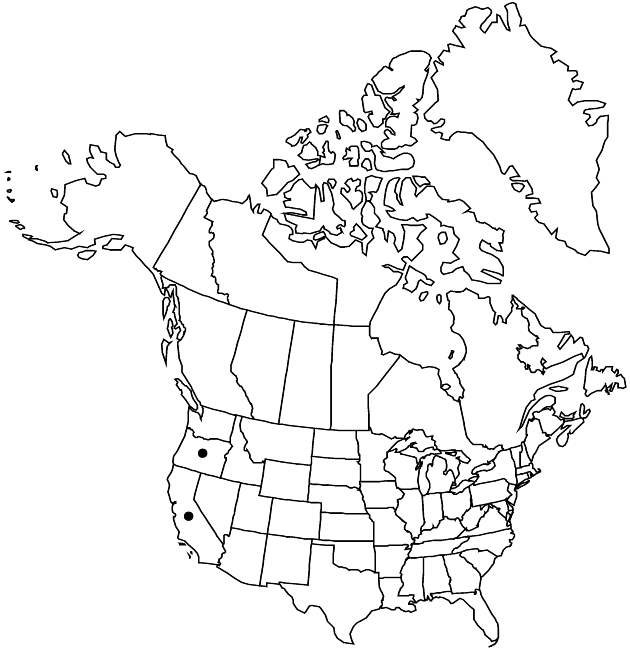Difference between revisions of "Hesperevax acaulis var. acaulis"
FNA>Volume Importer |
FNA>Volume Importer |
||
| Line 20: | Line 20: | ||
|elevation=30–900 m | |elevation=30–900 m | ||
|distribution=Calif.;Oreg. | |distribution=Calif.;Oreg. | ||
| − | |discussion=<p>Geographically, <i></i>var.<i> acaulis</i> is mainly intermediate with the other two varieties, usually occurring at lower elevations where sympatric. It is also morphologically intermediate in some characters. Typical forms, most frequent along the Sierra <i>Nevada</i> foothills, are distinguished by stems 0 and leaves narrowest relative to lengths. A recent collection from southwestern Oregon is intermediate toward <i></i>var.<i> robustior</i>; it may be introduced, or it may represent previously unsampled variation in the region.</p><!-- | + | |discussion=<p>Geographically, <i></i></i>var.<i><i> acaulis</i> is mainly intermediate with the other two varieties, usually occurring at lower elevations where sympatric. It is also morphologically intermediate in some characters. Typical forms, most frequent along the Sierra <i>Nevada</i> foothills, are distinguished by stems 0 and leaves narrowest relative to lengths. A recent collection from southwestern Oregon is intermediate toward <i></i></i>var.<i><i> robustior</i>; it may be introduced, or it may represent previously unsampled variation in the region.</p><!-- |
--><p>Kellogg’s protologue described pistillate paleae like those of <i>Stylocline</i>, suggesting that he may have been looking also at plants of <i>Ancistrocarphus keilii</i>. The two taxa are not known to be sympatric. The type material clearly belongs to <i>Hesperevax</i>. Besides its saccate pistillate paleae, <i>A. keilii</i> differs by petioles longer than blades with bases expanded, 3-nerved, and parchment-like.</p> | --><p>Kellogg’s protologue described pistillate paleae like those of <i>Stylocline</i>, suggesting that he may have been looking also at plants of <i>Ancistrocarphus keilii</i>. The two taxa are not known to be sympatric. The type material clearly belongs to <i>Hesperevax</i>. Besides its saccate pistillate paleae, <i>A. keilii</i> differs by petioles longer than blades with bases expanded, 3-nerved, and parchment-like.</p> | ||
|tables= | |tables= | ||
| Line 45: | Line 45: | ||
|publication year= | |publication year= | ||
|special status= | |special status= | ||
| − | |source xml=https://jpend@bitbucket.org/aafc-mbb/fna-data-curation.git/src/ | + | |source xml=https://jpend@bitbucket.org/aafc-mbb/fna-data-curation.git/src/f6b125a955440c0872999024f038d74684f65921/coarse_grained_fna_xml/V19-20-21/V19_786.xml |
|tribe=Asteraceae tribe Gnaphalieae | |tribe=Asteraceae tribe Gnaphalieae | ||
|genus=Hesperevax | |genus=Hesperevax | ||
Revision as of 19:38, 24 September 2019
Plants 1–2(–4) cm. Stems usually 0, sometimes 1(–7), ± prostrate; branches 0. Leaves basal or cauline, sessile or obscurely petiolate, largest mostly 7–12 × 0.5–2 mm; petiole lengths 0–0.8 times blade lengths; blades oblanceolate, acute; capitular leaves ± erect. Heads borne singly or, sometimes, in glomerules of 2–8, largest 2.5–3 × 2–2.5 mm. Receptacles 0.8–1.4 × 0.8–1.4 mm. Pistillate paleae in 3–5 series, 2–3 mm. Staminate paleae: longest 1.9–2.4 mm. Functionally staminate florets 2–12; corollas 0.7–1 mm. Cypselae mostly 0.6–0.8 mm.
Phenology: Flowering and fruiting mid Mar–mid May.
Habitat: Open, dry or vernally moist, sandy to gravelly soils in swales, drainages, grasslands, chaparral, woodland clearings, sometimes in moss or other turf
Elevation: 30–900 m
Discussion
Geographically, var. acaulis is mainly intermediate with the other two varieties, usually occurring at lower elevations where sympatric. It is also morphologically intermediate in some characters. Typical forms, most frequent along the Sierra Nevada foothills, are distinguished by stems 0 and leaves narrowest relative to lengths. A recent collection from southwestern Oregon is intermediate toward var. robustior; it may be introduced, or it may represent previously unsampled variation in the region.
Kellogg’s protologue described pistillate paleae like those of Stylocline, suggesting that he may have been looking also at plants of Ancistrocarphus keilii. The two taxa are not known to be sympatric. The type material clearly belongs to Hesperevax. Besides its saccate pistillate paleae, A. keilii differs by petioles longer than blades with bases expanded, 3-nerved, and parchment-like.
Selected References
None.
